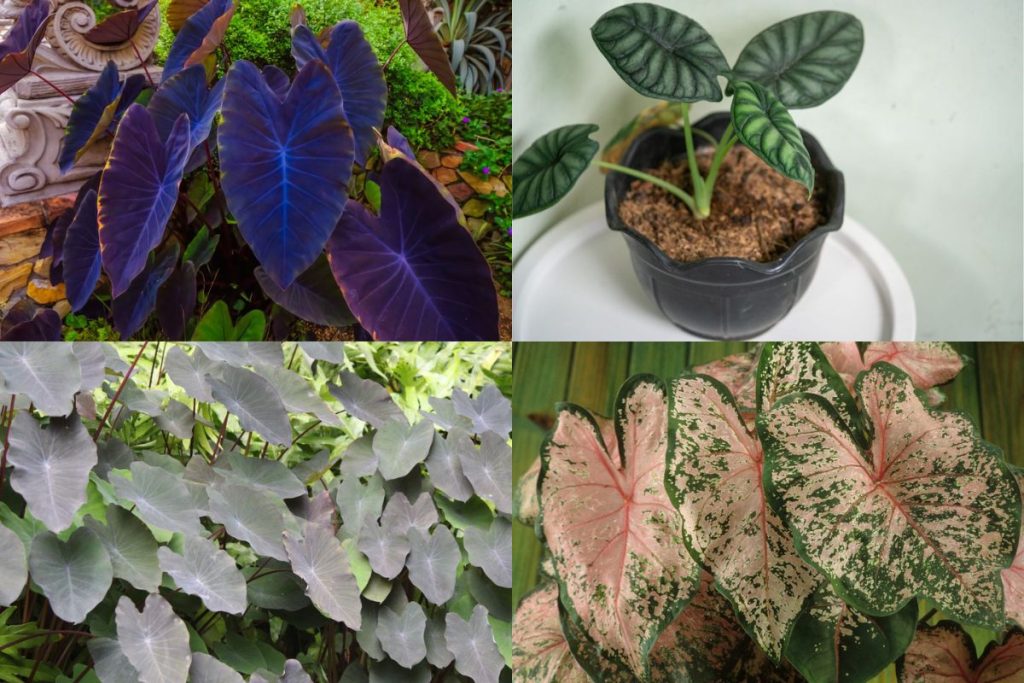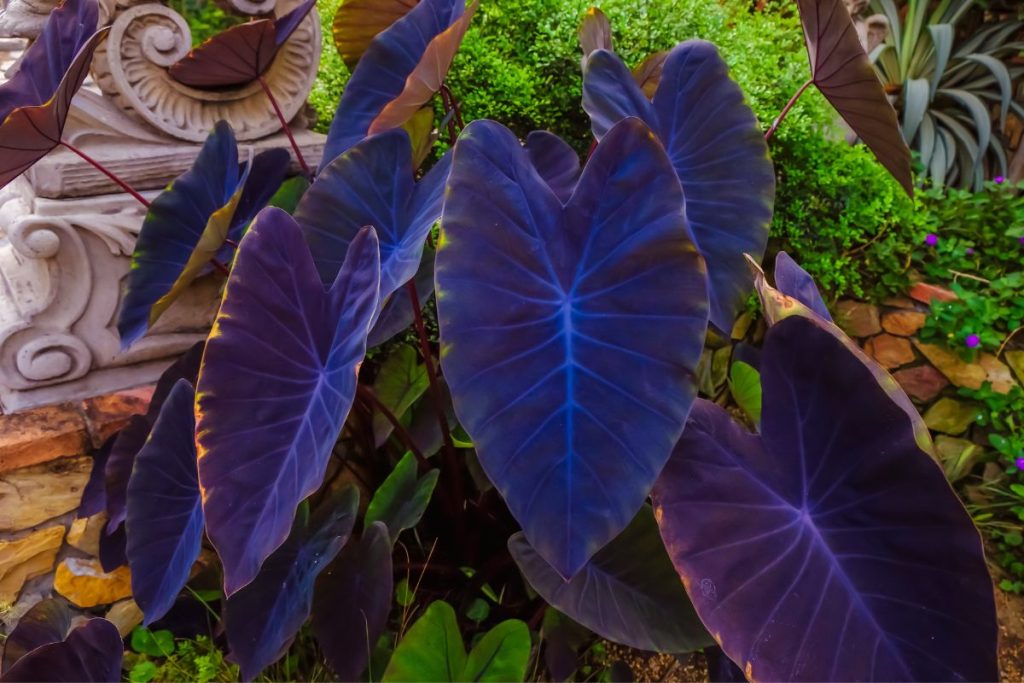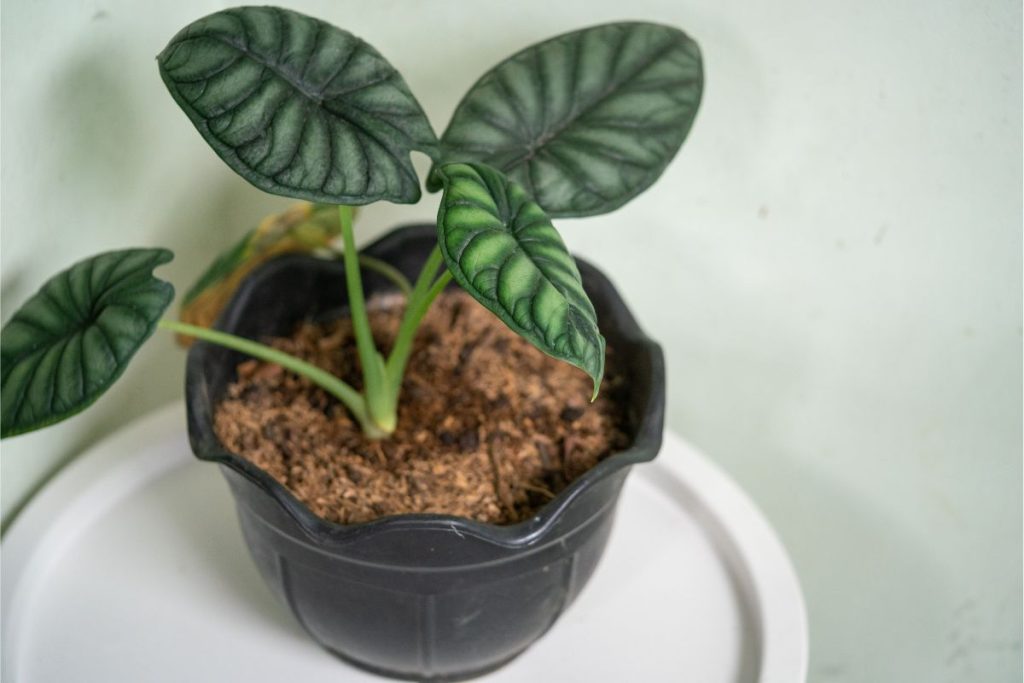Are you looking for a low-maintenance and beautiful way to spruce up your garden? Look no further than the array of elephant ear plants! From small clumping varieties to tall running types, there are many stunning options available. Learn all about the four different elephant ear plants and how to safely grow them with this helpful guide.

Contents
What Are The 4 Different Elephant Ear Plants?
You may have heard of elephant ear plants, but did you know there are four main types? Colocasia, Alocasia, Xanthosoma and Caladium are the four different types of elephant ear plants. All of them can be grown in warm climates and need plenty of water and direct sunlight to thrive. Each species has its own unique characteristics, so if you’re looking for an exotic addition to your garden, one of these varieties might be just right for you.
Colocasia
Colocasia plants are commonly known as taro or elephant ears. They are native to Southeast Asia and are characterized by their large, heart-shaped leaves. These leaves can vary in color, ranging from green to shades of purple or black. Colocasia plants typically have a more rigid leaf structure and are known for their edible underground corms, which are starchy and used in various culinary dishes. They prefer moist soil conditions and thrive in full or partial sun.
Alocasia
Alocasia plants, also called African mask or elephant ear plants, are mainly native to tropical Asia and Australia. They are recognizable for their arrowhead-shaped leaves with intricate vein patterns. Alocasia leaves come in various sizes and colors, including shades of green, silver, or purple. Alocasia plants generally have a more upright growth habit compared to other elephant ear species. They prefer well-draining soil and partial shade with some indirect sunlight.
Related Post:
Alocasia vs Colocasia: Similarities & Differences of the Elephant Ears
Xanthosoma
Xanthosoma, commonly known as malanga or elephant ear, originates from tropical regions in Central and South America. These plants have broad, heart-shaped leaves similar to Colocasia, but the leaf structure is often more elongated. The color of Xanthosoma leaves varies from green to deep shades of burgundy or bronze. Xanthosoma plants tend to be larger in size compared to other elephant ear species. They prefer rich, well-draining soil and partial shade.
Caladium
Caladium plants, sometimes referred to as angel wings or elephant ear plants, are native to tropical America, particularly the humid regions of Brazil and Peru. Caladium leaves are arrowhead-shaped and come in a wide range of vibrant colors, including combinations of green, red, pink, or white. The patterns on their leaves can be marbled, spotted, or veined, adding to their decorative appeal. Caladiums are primarily grown for their attractive foliage and are commonly used in landscaping or as houseplants. They thrive in well-drained soil and require partial or filtered shade.
Identifying The 4 Different Elephant Ear Plants
Leaf Shape and Size
- Colocasia: Large, heart-shaped leaves.
- Alocasia: Arrowhead-shaped leaves with intricate vein patterns.
- Xanthosoma: Broad, heart-shaped leaves typically more elongated.
- Caladium: Arrowhead-shaped leaves with vibrant colors and decorative patterns.
Leaf Color
- Colocasia: Mostly green but can have shades of purple or black.
- Alocasia: Various shades of green, silver, or purple.
- Xanthosoma: Green with potential for deep shades of burgundy or bronze.
- Caladium: Varied combinations of green, red, pink, or white.
Growth Habit
- Colocasia: Generally has a more rigid, upright growth habit.
- Alocasia: Exhibits an upright growth habit.
- Xanthosoma: Large and tends to grow larger compared to others.
- Caladium: Grows as shorter, bushy plants suitable for containers or landscaping.
Preferred Growing Conditions
- Colocasia: Thrives in moist soil conditions and full or partial sun.
- Alocasia: Thrives in well-draining soil and partial shade with indirect sunlight.
- Xanthosoma: Prefers rich, well-draining soil and partial shade.
- Caladium: Requires well-drained soil and does well in partial or filtered shade.
Note: While all these plants are referred to as elephant ear plants, their specific attributes and preferences can differ. It’s important to consider the individual requirements of each plant to ensure optimal growth and care.
How To Grow The 4 Different Elephant Ear Plants
You have four different types of elephant ear plants that you can grow in your garden or home. Colocasia, Alocasia, Xanthosoma, and Caladium are all wonderful additions to your landscaping. Let’s take a look at how to properly care for each of these unique plants so that they thrive and bring a little bit of the tropics into your life!
Colocasia

Light
Light is essential for elephant ear plants to thrive; they need bright, indirect sunlight for at least six hours a day. This means keeping them away from direct rays and in an area with light shade. When you’re selecting a spot for your plant, make sure it’s not too close to windows or other sources of heat that can cause the leaves to burn. If your elephant ear isn’t getting enough light, its leaves may start yellowing or turning brown. To help ensure optimal growth, provide adequate light and watch out for signs of sunburns or other health problems.
Water
Water is essential for your elephant ear plant to stay healthy; be sure to provide it with enough moisture, especially during the warmer months. Make sure to water deeply but not too often, and avoid leaving the soil overly soggy. Keep an eye out for wilting or yellowing leaves—these can indicate either too much or too little water. If you’re unsure if your plant needs watering, stick a finger into the soil a few inches down: if it feels damp, wait another day or two before watering again.
Temperature & Humidity
Now that you’ve got the water needs of elephant ear plants sorted, let’s talk about temperature and humidity. The ideal temperature range for most varieties is between 60-85 degrees Fahrenheit. It’s important to keep temperatures consistent, as sudden changes can cause stress or damage to the plant. Humidity should be kept at a moderate level; too little will cause leaves to brown and curl, while too much can lead to mold and disease. Keeping your elephant ear plant in a bright spot with plenty of airflow will help maintain the perfect environment for it!
Soil
Soil is crucial for elephant ear plants to thrive – it should be well-draining and contain some organic matter. Ensure that the soil you select is free of contaminants, and if you are uncertain of the safety of the soil, opt for a purchased potting mix instead. To optimize growth, add compost to enrich the soil. Make sure it’s evenly distributed and mix it in thoroughly before planting your elephant ears. This will help ensure they get all the nutrition they need to grow healthy and strong.
Fertilizer
Fertilizing elephant ear plants is essential for their growth, so fertilize regularly with a balanced fertilizer to ensure they get the nutrition they need. It’s important to read and follow label instructions carefully when applying any fertilizer, as over-fertilizing can be harmful. Use slow-release fertilizers or liquid feedings every two weeks for best results. Be sure to wear gloves and safety glasses to protect yourself while handling fertilizer products. Regularly monitor soil moisture levels to avoid root burn from excess fertilizer salts. Keep your elephant ear plants healthy and happy with proper fertilizing!
Alocasia

Light
Light is an important factor in growing elephant ear plants. Alocasia, for example, requires bright indirect light and some direct sun. When grown indoors, place your plant near a south-facing window. Avoid too much sun exposure as this can cause the leaves to burn or wilt. Make sure the soil remains moist but not soggy to promote healthy growth. If you are growing outdoors, ensure that it is getting enough protection from direct sunlight during the hottest hours of the day.
Water
Watering your elephant ear plant is vital to its health. Be sure to keep the soil moist, not saturated. Too much water can cause root rot. Use only enough for moisture and avoid overwatering. Check the soil before each watering to ensure it’s not too wet. Add water little by little until the desired moisture level is reached. Make sure your pot has adequate drainage, so excess water can escape quickly.
Temperature & Humidity
It’s important to keep your Alocasia plant in an environment with moderate humidity and temperatures between 65-85 degrees Fahrenheit. You should avoid sudden drops or rises in temperature, as this can be harmful to the plant. Be sure to check your humidity levels frequently, as these plants prefer 40-50%. If it gets too dry, you can add a humidifier or mist the leaves occasionally. Keeping these conditions stable will help ensure that your elephant ear plant stays healthy and happy!
Soil
Choosing the right soil for your Alocasia plant is important to keep it healthy. Use a well-draining, light potting mix that provides good aeration and moisture retention. Always make sure the soil is damp, but not soggy when you water your plant. Don’t let it sit in standing water either! Provide plenty of organic matter to ensure an optimal balance of nutrients and help retain moisture. A pH between 6.1 and 6.5 is ideal for Alocasia plants. Test the level of acidity with a home testing kit if needed, and adjust accordingly with a fertilizer or soil amendment like sulfur or lime.
Fertilizer
Fertilizing your Alocasia plant is essential for optimal growth and health. For best results, use a balanced fertilizer that specifically states it is suitable for elephant ear plants with an N-P-K ratio of 10-10-10. Apply the fertilizer every two weeks during the growing season and every four to six weeks in the winter months. Be sure to water before adding fertilizer as dry soil will not absorb it properly. Additionally, avoid fertilizers with large amounts of nitrogen as this can burn the leaves and cause yellowing.
Xanthosoma

Light
Providing the right amount of light is key to successful growth for elephant ear plants. Xanthosoma varieties require bright, indirect sunlight to thrive. If you can’t provide enough natural light, you may need to supplement with artificial lighting. Make sure your plant has enough space from other plants so it doesn’t get too much sun or shade. Always use caution when using electric lights near water or plants as they can cause electrical shock or fire hazards.
Water
Watering your elephant ear plants correctly is essential for their health. To keep them thriving, water deeply and allow the soil to dry between watering. Make sure you use a container with drainage holes at the bottom so that excess water can escape. Avoid overwatering as this can lead to root rot or other damage to the plant. Never let your elephant ear sit in standing water, as this will quickly cause it to die.
Temperature & Humidity
Optimal temperature and humidity levels are key to keeping your Xanthosoma plants healthy. Generally, these plants prefer temperatures between 65-85 degrees Fahrenheit and a humidity level of 50-70%. When the humidity is too low, their leaves will start to brown. Too high of a temperature can cause the leaves to become limp and yellow. To ensure your plant stays healthy, make sure you keep the temperature consistent and monitor the relative humidity in its environment.
Soil
Xanthosoma plants prefer soil that drains well and is rich in organic matter, so it’s important to use a potting mix specifically designed for them. Try to avoid using soil from your garden as this can bring unwanted pests or diseases into the container. Always ensure the potting mix is moist but not soggy before planting your Xanthosoma, and if necessary add water-retaining crystals to help with moisture levels. Aim for a pH range of 5.5–6.5; too acidic or alkaline soils will stunt the growth of your plant. Fertilize regularly with a slow-release fertilizer when the plant is actively growing for best results.
Fertilizer
Fertilize regularly with a slow-release fertilizer to keep your Xanthosoma plant healthy and thriving. Use a balanced fertilizer that contains equal amounts of nitrogen, phosphorus, and potassium, or NPK for short. Make sure to follow the directions on the label as fertilizers with too high of an NPK ratio can damage the plant’s root system. When applying, take care not to get any fertilizer on the foliage as it may cause burning or spotting. Keep your elephant ear plant nourished and safe from harm by using just the right amount of fertilizer.
Caladium

Light
Light is an essential factor for the growth of elephant ear plants, so it’s important to give them plenty of sunlight. Place your elephant ears in a spot that receives full sun for at least six hours per day; this will ensure they grow and flourish. Avoid placing these plants in partial shade or very windy locations as this can be damaging to their foliage. If you live in a climate where temperatures become too hot during the summer, provide some afternoon shade to protect your elephant ears from heat stress. Additionally, try to water consistently and make sure the soil is draining properly so that your plant does not become overwatered.
Water
Watering your elephant ear plants is essential for their health and growth; be sure to provide them with consistent moisture. Check the soil’s moisture level every two or three days, and water when the top of the soil feels dry. Aim for one inch of water per week, but adjust as needed depending on your climate and weather conditions. Do not overwater, as this can cause root rot. Monitor any drainage holes, ensuring that they are free from debris and that excess water can escape properly. Following these tips will help ensure that your elephant ear plants stay healthy and thrive.
Temperature & Humidity
Now that you know how to provide your elephant ear plants with the right amount of water, it’s crucial to understand the temperature and humidity needed for proper growth. Keeping temperatures between 65-80 degrees Fahrenheit is recommended, as too much heat can cause burning and wilting leaves. Humidity should be kept higher than usual for indoor plants; a humidifier can help keep levels high. Make sure not to leave your plant in direct sunlight or in an area prone to drafts. With the right temperature and humidity levels, your elephant ear plant will thrive!
Soil
For your elephant ear plant to thrive, it’s essential that you use the right soil. Opt for a potting mix with good drainage, such as one that contains peat moss and perlite. If necessary, add some compost or well-rotted manure for additional nutrients. Be sure to avoid using garden soil from outside – this can contain pests and fungi that could harm your plant. Lastly, make sure the soil is consistently moist but not soggy; check it regularly for optimal growth!
Fertilizer
Fertilizing your elephant ear plant is essential to keeping it healthy; use a balanced liquid fertilizer every two weeks for best results. Plant food should be diluted according to the package instructions. Avoid fertilizers with high nitrogen content as this may damage the plant, and opt for products that are specifically tailored to houseplants. When applying fertilizer, make sure not to get any on leaves or stems, as this can cause burning. Giving your elephant ear plant proper nutrition will help ensure beautiful foliage for years to come.
How To Propagate The Different Elephant Ear Plants
Divide the tuber at the end of the growing season, and store it until spring to propagate elephant ear plants. Wear gloves when handling the tuber to protect your skin from its sap. With a sharp, sterile knife, carefully cut through the tuber into clumps, each having at least one growth node. Allow cuts to dry and scab over while sitting on a tray or plate in a dry location away from direct sunlight.
After about a week, wrap in paper and store in a cool spot above freezing temperatures until spring arrives after any risk of frost has passed. When ready for planting, follow the same steps as you would with newly purchased tubers.
An alternative method is to grow from seed which is less reliable but possible by sprinkling seeds over a seed-starting mix that’s been lightly sprayed with water. Seedlings can appear within weeks; keep the tray in indirect bright light for best results. Always handle tubers with care and take precautions like wearing gloves for safety reasons!
Related Posts:
How To Plant Caladium Bulbs
How To Grow Alocasia From Bulb
Clumping Vs Running Elephant Ears
Knowing whether your elephant ears are clumping or running can help you decide where to plant them. Elephant ears can be divided into two main categories: the clumpers and the runners. While traditional varieties of Colocasia esculenta var. aquatilis tend to spread via above-ground runners, modern cultivars have far less vigorous spreading habits. The only colocasia that spreads through below-ground runners is Colocasia esculenta ‘Illustris’ and its close cousins, such as Colocasia esculenta var. antiquorum ‘Black Beauty’ and Colocasia esculenta ‘Coal Miner’.
Clumping varieties have a more vase-like shape in the garden, making them ideal for limited spaces as they don’t take over quickly like their runner counterparts may if not monitored closely. When deciding which type to grow, it’s important to consider your local climate; while both types do well in cooler climates, runners will need extra attention in warmer climates due to their rapid growth rate. Planting either type of elephant ear correctly offers a safe way to enjoy these gorgeous plants without worry of them taking over your space!
Conclusion
You now know the four different elephant ear plants, how to grow them, and how to propagate them. Clumping elephant ears are great for pots while running types are best for in-ground gardens. With a little effort and patience, you’ll have beautiful foliage that will last throughout the season. Why not try out one of these amazing plants in your own garden? You won’t regret it!
